In the quiet mountains of Shimane Prefecture, there lived a craftsman who mastered the essence of “washi,” a cultural heritage of Japan.
Eishiro Abe — his name has become legendary in the world of washi, and he is still remembered as an innovator who breathed new life into traditional Japanese crafts.
His life was not merely the story of a papermaker, but a grand cultural voyage that demonstrated the crystallization of Japanese aesthetics and techniques to the world.
Eishiro Abe’s Early Life and Encounter with Washi
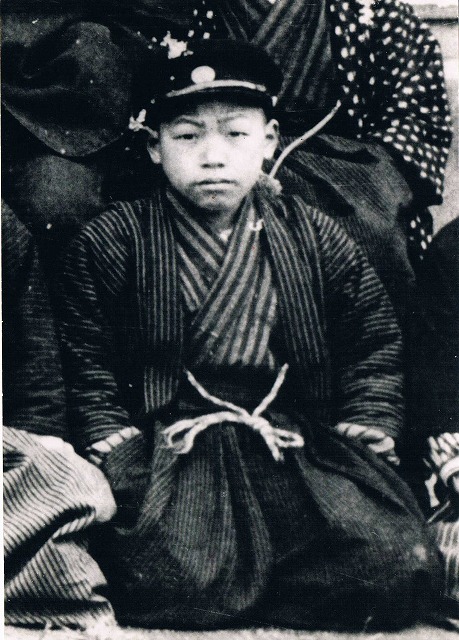
Eishiro Abe was born on January 14, 1902 (Meiji 35) into a papermaking family in Yakumo Town, Yatsuka County, Shimane Prefecture (now Yakumo Town, Matsue City). From an early age, he acquired the fundamentals of washi making while helping with the family business.
What’s notable is that Yakumo Town where he grew up was not a particularly famous washi-producing region. This environment gave Eishiro a unique spirit of inquiry and creativity. Rather than being bound by regional constraints, his characteristic became a voluntary attitude to refine his own sensibility and technique.
In 1923 (Taisho 12), at the age of 21, Eishiro joined the Paper Department of the Shimane Industrial Testing Center, where he researched various papermaking methods. His experience there became his technical foundation, and later he began providing technical guidance to papermakers in Shimane Prefecture. These steady efforts and training would eventually lead to the birth of “Izumo Mingei Paper.”
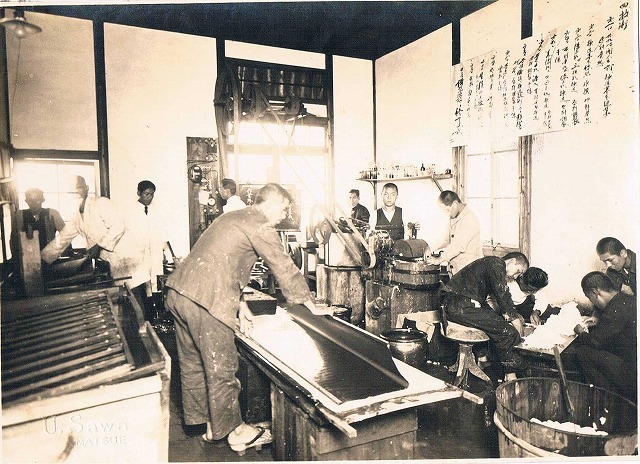
Journey as a Washi Craftsman and Technical Innovation
What dramatically changed Eishiro’s life was his encounter with Soetsu Yanagi, the founder of the Folk Craft Movement, in 1931 (Showa 6). When Yanagi visited Matsue and saw the thick ganpi paper that Eishiro had made, he praised it saying, “This is truly Japanese paper,” which became the catalyst for Eishiro to participate in the Folk Craft Movement.
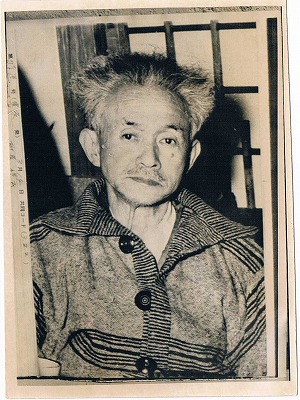
Through this encounter, Eishiro began to pursue new possibilities for washi. He pioneered unique methods of expression while preserving the inherent material beauty of washi, going beyond conventional frameworks.
Birth and Characteristics of Izumo Mingei Paper
The most distinctive feature of “Izumo Mingei Paper” created by Eishiro was how he maximized the individual characteristics of each raw material. He made different papers using kozo, mitsumata, and ganpi as separate materials rather than mixing them, utilizing the specific properties of each.
>> Introduction to Izumo Washi
Kozo paper is strong with a rustic texture, mitsumata paper is delicate and resistant to insects, and ganpi paper has a beautiful luster and excellent durability. Eishiro thoroughly understood these characteristics and pursued the optimal papermaking method for each material.
Furthermore, he developed innovative expression methods such as “Wasomeishi” (naturally dyed paper) that utilized the characteristics of washi, and “Sukimoyo-shi” (pattern paper) that incorporated fiber designs using water movement. In particular, “Izumo Kumo-shi” (cloud paper), which expressed the evening scenery of Lake Shinji, fascinated many people with its artistic excellence that transcended practicality.
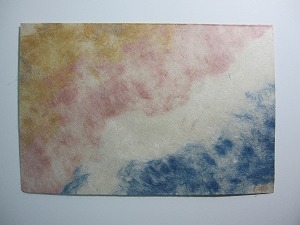
*We carry various Izumo Kumo-shi products.
- Roll Paper (Izumo Kumo-shi)
- Izumo Kumo-shi Postcards (5 sheets)
- Wacho (Washi Notebook) (Izumo Kumo-shi, Small Horizontal)
- Wacho (Washi Notebook) (Izumo Kumo-shi, Small Vertical)
- Wacho (Washi Notebook) (Izumo Kumo-shi, Large Vertical)
- Letter Set (Izumo Kumo-shi)
- Izumo Kumo-shi Tanzaku (5 sheets)
- Izumo Washi Envelopes (Izumo Kumo-iro, 5 pieces)
- Izumo Kumo-shi Shikishi (5 sheets)
Involvement with the Folk Craft Movement
The Folk Craft Movement emphasized “beauty in utility,” a philosophy that finds beauty in everyday tools. Eishiro resonated with this ideal and deepened his relationships with colleagues in the folk craft movement, including Soetsu Yanagi, Kanjiro Kawai, Bernard Leach, and Shiko Munakata.
Through their mutual inspiration, Eishiro’s washi came to be recognized as “mingei” (folk craft) with artistic value, rather than merely a traditional craft. Particularly noteworthy was the “Washi Solo Exhibition” held in Tokyo in 1934 (Showa 9). It was an unprecedented attempt in washi history to hold an exhibition featuring the works of just one papermaker.
Beginning with this exhibition, Eishiro continued to hold exhibitions throughout Japan for the rest of his life, consistently showcasing the beauty and potential of washi to the world.
>> People Who Had Close Relationships with Eishiro Abe
Reasons for Being Designated as a Living National Treasure
In 1968 (Showa 43), Eishiro Abe was designated as a holder of Important Intangible Cultural Properties (Living National Treasure) for his traditional techniques in making ganpi paper. This honor was a national recognition of his outstanding skills and creativity.
The primary reason cited for his designation was his preservation and continuation of traditional techniques. Ganpi paper, in particular, was limited to a few craftsmen who could make it due to the difficulty of its production, but Eishiro mastered this technique and developed it further.
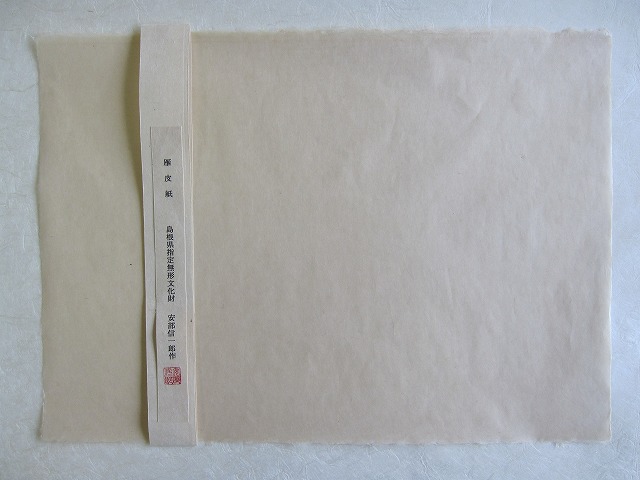
*We also carry various Izumo Ganpi Paper products.
- Ganpi Paper
- Izumo Ganpi Paper Wacho
- Izumo Ganpi Paper Tanzaku (5 sheets)
- Izumo Ganpi Paper Stationery (20 sheets)
- Izumo Ganpi Paper Shikishi (5 sheets)
Additionally, his research and investigation of papers in the Shosoin treasures, conducted over eight years from 1960 (Showa 35), was highly acclaimed. Eishiro, together with washi researcher Bunsho Jugaku and others, analyzed thousand-year-old papers and successfully recreated them. This achievement became an important accomplishment that demonstrated the historical continuity of Japanese washi culture.
Furthermore, Eishiro’s washi was also valued for its fusion of practicality and artistry at a high level. Its excellent durability, insect resistance, and beautiful texture — these characteristics align with the principles of sustainable craftsmanship in modern times.
>> Living National Treasures of Handmade Washi
Contributions to the Inheritance and Development of Traditional Techniques
Eishiro was also passionate about passing his techniques on to the next generation. As the culmination of this effort, he established the “Eishiro Abe Memorial Museum” and the “Handmade Washi Training Center” in 1983 (Showa 58). His aim was to preserve and exhibit valuable washi materials and folk crafts he had collected throughout his life, while also training washi technicians.
Currently, his grandsons, the brothers Shinichiro and Norimasa, carry on his spirit and techniques, continuing the tradition of Izumo Mingei Paper. The memorial museum offers washi-making experiences and workshop tours, becoming a cultural hub that attracts many visitors from both Japan and abroad.
Influence and Evaluation for Future Generations
Eishiro Abe’s washi is loved for various uses due to its practicality and beauty. As printmaking paper, business cards, preservation documents, and works of art — his works continue to demonstrate new possibilities for washi.
Particularly noteworthy are Eishiro’s international activities. In 1974 (Showa 49), he held a solo exhibition in Paris, and subsequently organized exhibitions in cities around the world including New York, Los Angeles, San Francisco, and Beijing. These activities are highly regarded as pioneering efforts to introduce Japanese traditional crafts to the world.
Throughout his life, Eishiro continuously asserted that “washi is not merely a consumable item, but an artwork in itself.” His attitude of respecting the techniques and individuality of papermakers and enhancing the value of locally-rooted crafts has had a significant influence on the contemporary craft movement.
At the Eishiro Abe Memorial Museum, visitors can see not only Eishiro’s washi works but also works by many folk craft artists including Soetsu Yanagi and Bernard Leach, as well as works by Shiko Munakata, with whom he had a deep friendship. Through these, one can feel the richness of cultural bonds that expand from a single material, washi.
Eishiro Abe passed away on December 18, 1984 (Showa 59) at the age of 82, but the spirit of “beauty in utility” and the outstanding techniques he pursued throughout his life continue to fascinate and inspire many people.
